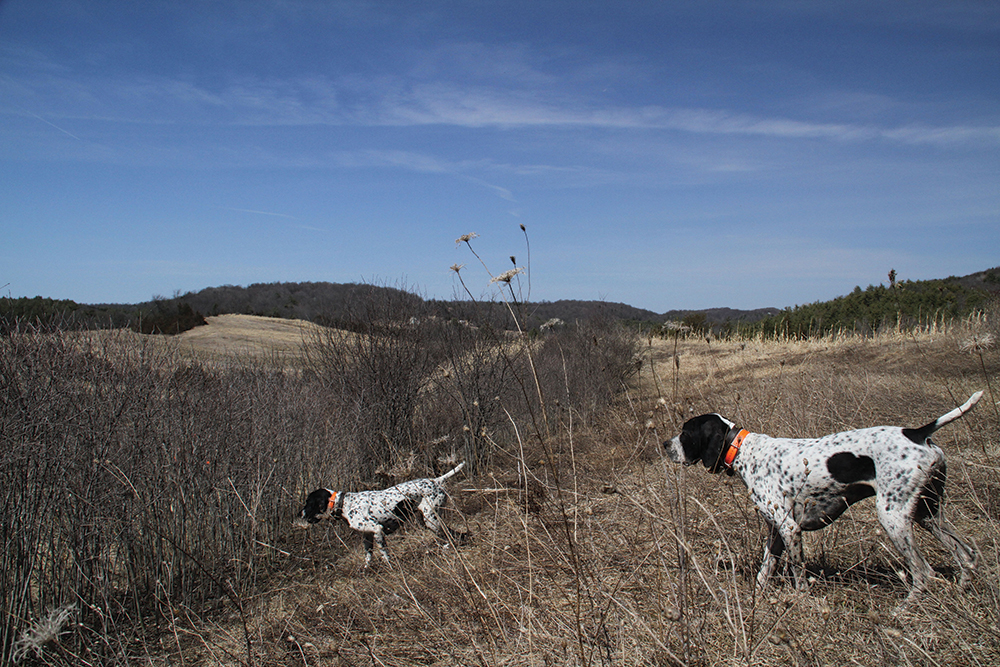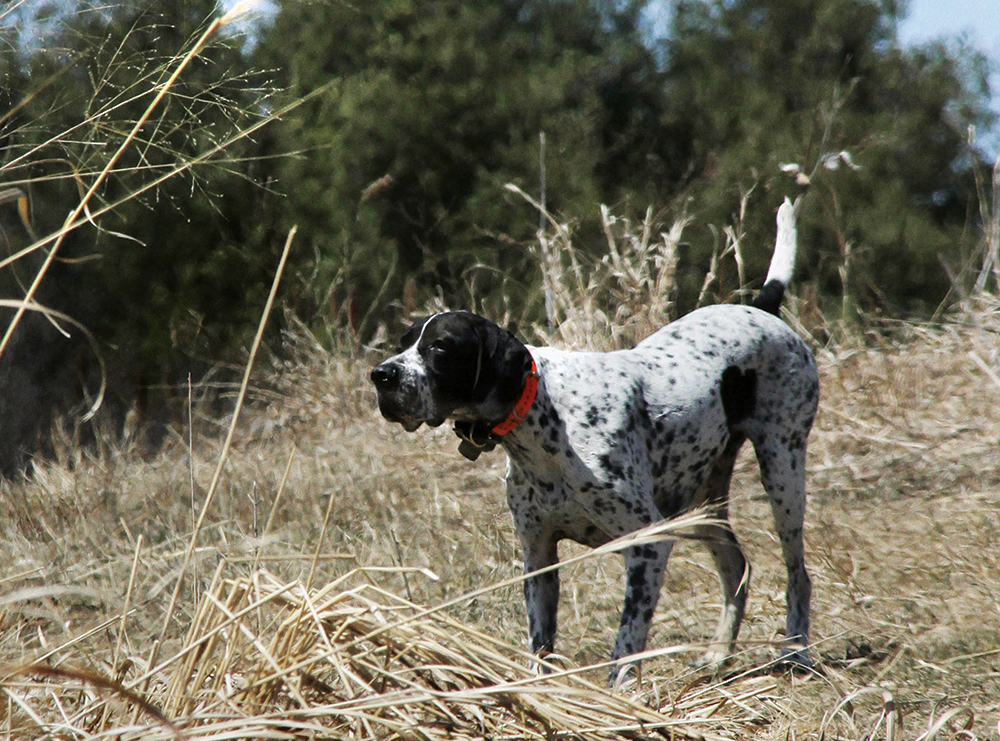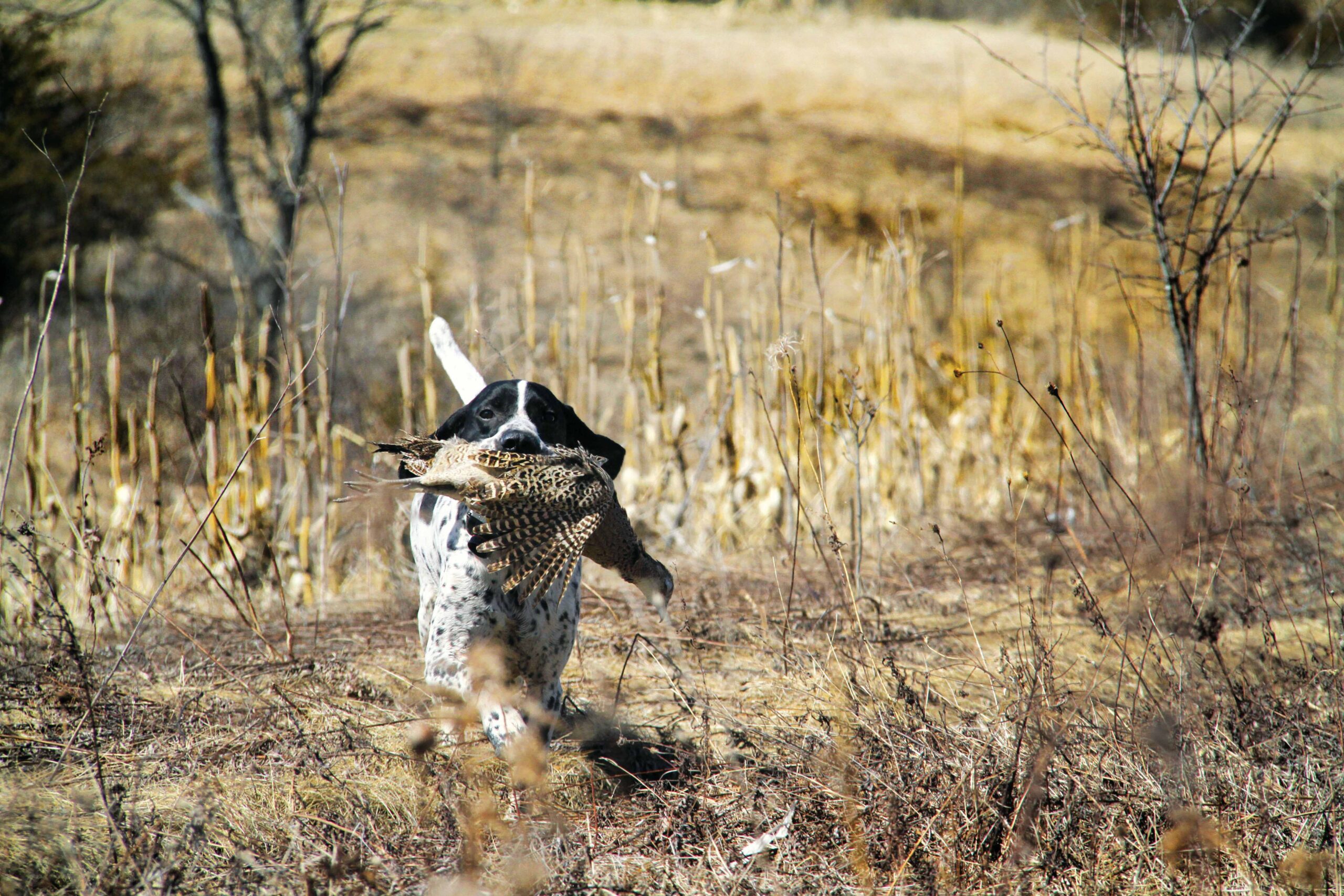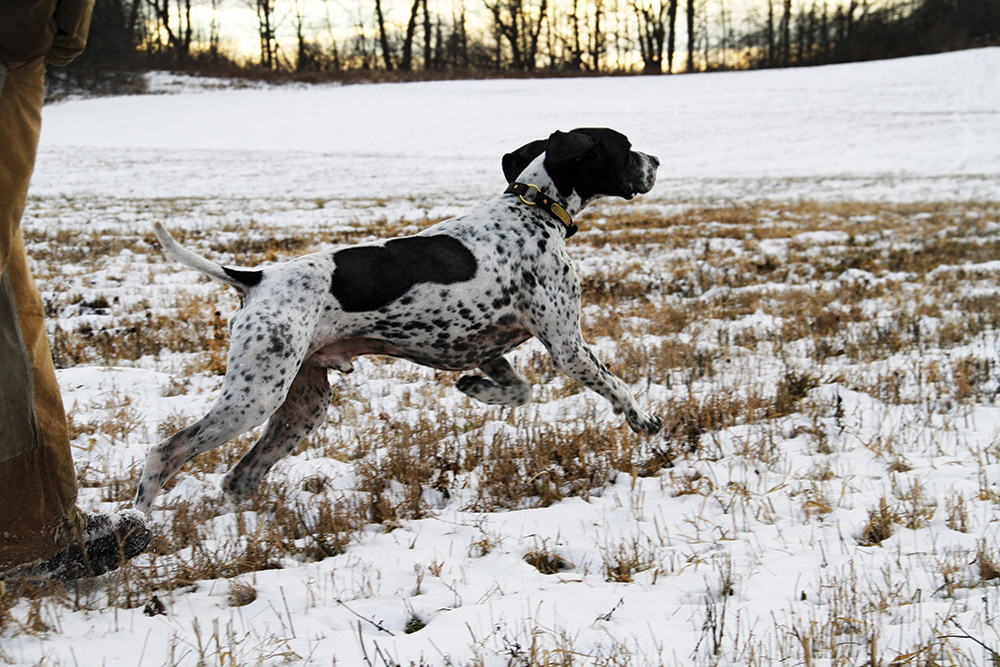Braques D’auvergne

Fiona spun on point, her deep-jowled black muzzle pointed downhill into a thicket of raspberry whips. The muscles in her shoulders were rigid, clearly defined through her short white fur. A second later, Finn sprinted over the rise behind her and froze, honoring her point. Most of us pointing dog people have seen it a hundred times, but we never get tired of admiring. Two, or more, dogs on point backing naturally without commands is a sight that never gets old. I’d even say that elegant backing ranks right up there with slam-dunk points and 100-yard retrieves as the fuel that keeps our passion for bird dogs afire.
“Look at that! Did you see that?” Finn’s owner, Jeff Parker, called out.
“Beautiful,” I replied. Fi’s owner, Jim Wells, just smiled.
I’m sure a bird flushed and was shot or missed, but I mostly remember the point and back. That was the first time I hunted over Fi and Finn, 6-year-old braque d’Auvergne littermates. We were having a little postseason bird fun at Peaceable Hill, a rolling pheasant preserve in mid-state Vermont. On the cusp of mud season in early April, the dogs’ bright white coats and velvety black heads stood out in stark contrast to the brown landscape. Fi and Finn know the released pheasant, and with the help of Steve Leffler’s braque Français, Ella, they seemed to be taking us hunters hunting, not the other way around. They cruised and crisscrossed, deftly locating the roosters and waiting in stylish points with a touch of impatience while the guns moved in position and did their job. Enthusiastic retrievers, all three raced out for the fetch but politely deferred to whoever got there first.

Like the majority of braques d’Auvergne, both of these striking pointers have ample, houndy heads, but Fi has a thin line of white up her nose and serious eyes. Finn has broader white markings on his muzzle and tends to square off his ears and tip his head more. They are both professionals when it comes to flinging strings of slobber when they run.
Hunting late-season ruffed grouse with Fi and Finn several months later, I noticed their hunting style was clearly different than at the pheasant preserve. True to the definition of “versatile hunting dog,” as they moved from thick grouse woods to apple orchard to farm field edges, their pace and range shifted. I asked Jim about the d’Auvergne’s typical range.
“A lot of people ask that,” Jim replied. “But my answer always is, ‘that depends on where they’re hunting.’ They adapt to the cover, hunting closer in the woods and then, like at the preserve where the fields are wide, they can range out 100 yards or more. Either way, they keep checking back in. It’s a true partnership. Fi is always working with me.”
Jeff agrees. “One characteristic of the breed is that they are all about trying to please you. They don’t tire and will hunt all day. And they make fantastic pets. If you don’t want a dog to cuddle in your lap, don’t get one of these.”
We were also running Mackenzie, Jeff’s 7-month-old d’Auvergne puppy from Legacy Bleus Kennel in Michigan. Jeff’s family calls Mackenzie an “Imperial walker,” referring to the long-legged armored transports in Star Wars that seem to flip oversized feet one at a time in a plodding angular motion. There’s nothing plodding about Mackenzie, but at that gawky teenage stage, each foot did seem to plop out in a different direction with little regard for what the other three feet were doing. She bounded through the woods, often running into or over Fi or Finn, who were focused on the hunt and paid little attention to her. When several gunshots went off in the distance, we were all pretty impressed to see Mackenzie snap erect (one ear flipped over backwards, of course) facing the sound and refusing to move while she waited for another shot or perhaps a bird to fall.

Hailing from the Auvergne and Cantal regions of France, the braque D’Auvergne is considered one of the oldest pointers and the foundation for many subsequent continental European and British pointing breeds. Their history is charmed with a totally unproven legend involving Napoleon, various knights in battle, and a black-and-white pointer found on the island of Malta. The confidence level is higher, however, on a determination that the breed was in existence in the 1700s, had its standards officially recognized in the early 1900s, almost disappeared during World War II, and then was redeveloped in the 1970s.
The breed’s current parent club is the Réunion des Amateurs du Braque d’Auvergne in France. The United Kennel Club and the North American Versatile Hunting Dog Association recognize the braque d’Auvergne, but with the small population of the breed in the United States, the American Kennel Club does not. And that’s not necessarily a bad thing. Given limited recognition, the braque d’Auvergne has not gone the way of several of the other more unusual hunting breeds, which became show ring darlings in which breeding for appearance took precedence over hunting traits.
Here in the US, building the braque d’Auvergne’s population is a challenge because of the small gene pool. Breeders like Jim and his Olde Carriage Braques Kennels in Vermont occasionally bring in dogs from Europe, but they also have an excellent online resource. Through the Braque d’Auvergne Pedigree Database, prospective breeders and buyers can research dogs’ health results, see photos of dogs, and calculate the inbreeding coefficient and ancestor loss coefficient, which help monitor the risk of hereditary defects showing up.
Even for nonbreeders, hunters simply wanting a braque d’Auvergne will find that getting one can be tricky. In 1987, Jim had a Brittany and wanted a second hunting dog. He was reading an article on the braque d’Auvergnes in Gun Dog when his wife Stephanie looked over the page and said, “Now there’s a dog I wouldn’t mind having!”
Jim contacted Nelson Hooe, who was highlighted in the Gun Dog piece. Nelson connected Jim with Oliver Bonfil in Guadeloupe, and Jim soon found himself on a plane to Miami to meet Oliver and Chase. Jim estimates that Chase was about the 15th d’Auvergne to enter the US. Thirty years later—and six more braques d’Auvergne for Olde Carriage Braques Kennels—there probably aren’t more than 100 braques d’Auvergnes in the entire US, including Jim’s youngest pup, brought in from Khyannes Kennel in Nagyberki, Hungary.

Grace, Jim’s third braque, imported from Germany in 2002, turned Jim’s hunting partner Jeff into a loyal braque d’Auvergne owner. “I went on a grouse and woodcock hunt with Jim and Grace and fell in love with her,” Jeff recalls. “Her work ethic was second to none. I’d had Labs and a springer, and was thinking about getting a German shorthair. But when I saw Grace in the field, that was it.”
A few generations of pups later, Jim and Jeff debate their aesthetic preferences when it comes to a braque d’Auvergne’s appearance. Jim is a diehard white body, black head guy. Jeff admires the less common charbonnée coat—a darker roan coat, named for its carbon color. Noted for their big-boned, athletic conformation, these dogs often give the impression that they’re larger than they really are. They’re midsized pointing dogs, their ears are set low and their tails are set relatively high and can be docked or left long. They have an easy gait and a remarkable desire to track—not surprising with those substantial jowls to help trap scent. Another appealing attribute is that their point develops early.
Several other French braques are also gaining popularity in the States. The braque de l’Ariège and braque Saint Germain are still rare, but the braque du Bourbonnais and braque Français are showing up more regularly in the quail fields, grouse woods, and hunt tests.
The braque du Bourbonnais is known for its freckled face and a coat with unique ticking patterns. Its colors vary from reddish brown to peach to white, with more distinctly dark ticking. The braque du Bourbonnais has a naturally very short tail (or may be considered “tail-less”) although some breeders dock the tails to a short nub. Small to medium in size, they work at a medium pace and range with a crisp point, natural retrieving ability, and soft temperament.
The elegant braque Français comes in two types—the bigger, slightly thicker-coated, less common Gascony and the smaller, faster, more popular Pyrenean. According to pointing dog researcher Craig Koshyk, the Pyrenean type outnumbers the Gascony type by more than 100 to 1. Small to medium dogs, their coats can be bright white with brown roan, white with brown patches, or even tricolored, which has tan markings. Both braque Français types have a reputation for strong desire and easy trainability.

It’s interesting that all of these French braque breeds tend towards soft temperaments. “You can’t yell at these dogs,” Jeff says. “They’ll shut down. The braques respond to praise, with a notable response. It’s not a trained response; it’s immediate and genuine.”
The rewards are undisputable. One of Jeff’s favorite moments with Finn came after a day of ruffed grouse hunting that hadn’t gone well. Finn had spent more time tracking moose than finding birds—not the kind of hunt that goes in the record books. The next day, though, Finn turned into a pointing maniac, including one of those magic moments when the dog was obstinately locked on point up a very steep hill by a blowdown that Jeff couldn’t believe could hold a grouse. Finn wouldn’t leave. Sure enough, the bird was on the other side. Finn’s patience was repaid with a flush, a shot, and a retrieve.
“Up in Maine last year, Fiona went on point and three birds went up, two to the right and one left,” Jim says. “I swung on the left bird but had no idea if I hit it, didn’t see it drop, couldn’t tell if it was down. The next thing I know, there’s Fi coming back over the rise with the bird, holding it proudly but with a look that also said, ‘Hey, it’s my job.’ That’s the hunting partnership I’m talking about.”
Originally published in Volume 5, Number 4 (June-July 2017) of Covey Rise.
























